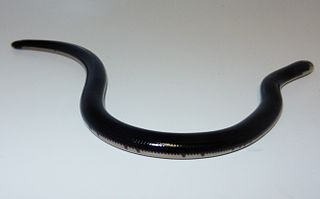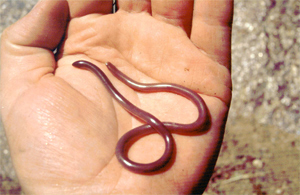
Amerotyphlops brongersmianus, known commonly as Brongersma's worm snake or the South American striped blindsnake, is a species of harmless blind snake in the family Typhlopidae. The species is native to South America and Trinidad and Tobago in the Caribbean. No subspecies are currently recognized.
Indotyphlops jerdoni, or Jerdon's worm snake, is a species of harmless blind snake in the family Typhlopidae. The species is endemic to India. There are no subspecies which are recognized as being valid.

Typhlops is a genus of blind snakes in the family Typhlopidae. The genus is endemic to the West Indies. Some species which were formerly placed in the genus Typhlops have been moved to the genera Afrotyphlops, Amerotyphlops, Anilios, Antillotyphlops, Argyrophis, Cubatyphlops, Indotyphlops, Letheobia, Madatyphlops, Malayotyphlops, and Xerotyphlops.
Xenotyphlops is a genus of snakes, the only genus of the family Xenotyphlopidae, comprising two species found only in Madagascar. These snakes are also known as the Malagasy Blind Snake.
The Saint Barts blind snake is a species of blind snake in the family Typhlopidae. The species is endemic to the Caribbean island of Saint Barthélemy, an overseas collectivity of France. The species was first described in 1999, and it is still not well known.
The Kimberley deep-soil blind snake is a species of snake in the family Typhlopidae. The species is endemic to Australia.
The buff-snouted blind snake is a species of snake in the family Typhlopidae. The species is endemic to Australia.
The Darwin blind snake is a species of snake in the family Typhlopidae. The species is endemic to Australia.
Rhinotyphlops scorteccii, commonly known as Scortecci's blind snake, is a species of snake in the family Typhlopidae. The species is endemic to Somalia.
Letheobia wittei, also known commonly as De Witte's gracile blind snake or Witte's beaked snake, is a species of snake in the family Typhlopidae. The species is endemic to Africa.
Typhlops capitulatus, commonly known as the Haitian pale-lipped blind snake or Richmond's worm snake, is a species of snake in the family Typhlopidae. The species is endemic to Haiti. There are no subspecies that are recognized as being valid.
Indotyphlops ahsanai is a species of snake in the family Typhlopidae. The species is endemic to Pakistan. Not further Study available about this species. Because their number is almost non-existent and their picture has not been recorded yet۔
The Cayman Brac blind snake is a species of snake in the family Typhlopidae.
Malcolm's worm snake is a species of snake in the family Typhlopidae.
Indotyphlops madgemintonae is a species of blind snake in the family Typhlopidae. The species is endemic to Pakistan. Not further Study available about this species. Because their number is almost non-existent and their picture has not been recorded yet۔

Amerotyphlops is a genus of snakes in the family Typhlopidae.

Antillotyphlops is a genus of snakes in the family Typhlopidae.
Malayotyphlops is a genus of snakes in the family Typhlopidae.

Xerotyphlops is a genus of snakes in the family Typhlopidae.
John Paul Richard Thomas is an American taxonomist and systematist, and retired professor of herpetology and evolution at University of Puerto Rico-Rio Piedras. He described several species new to science, mostly amphibians and reptiles, from throughout the Caribbean islands including the common coquí, the national animal of Puerto Rico.




